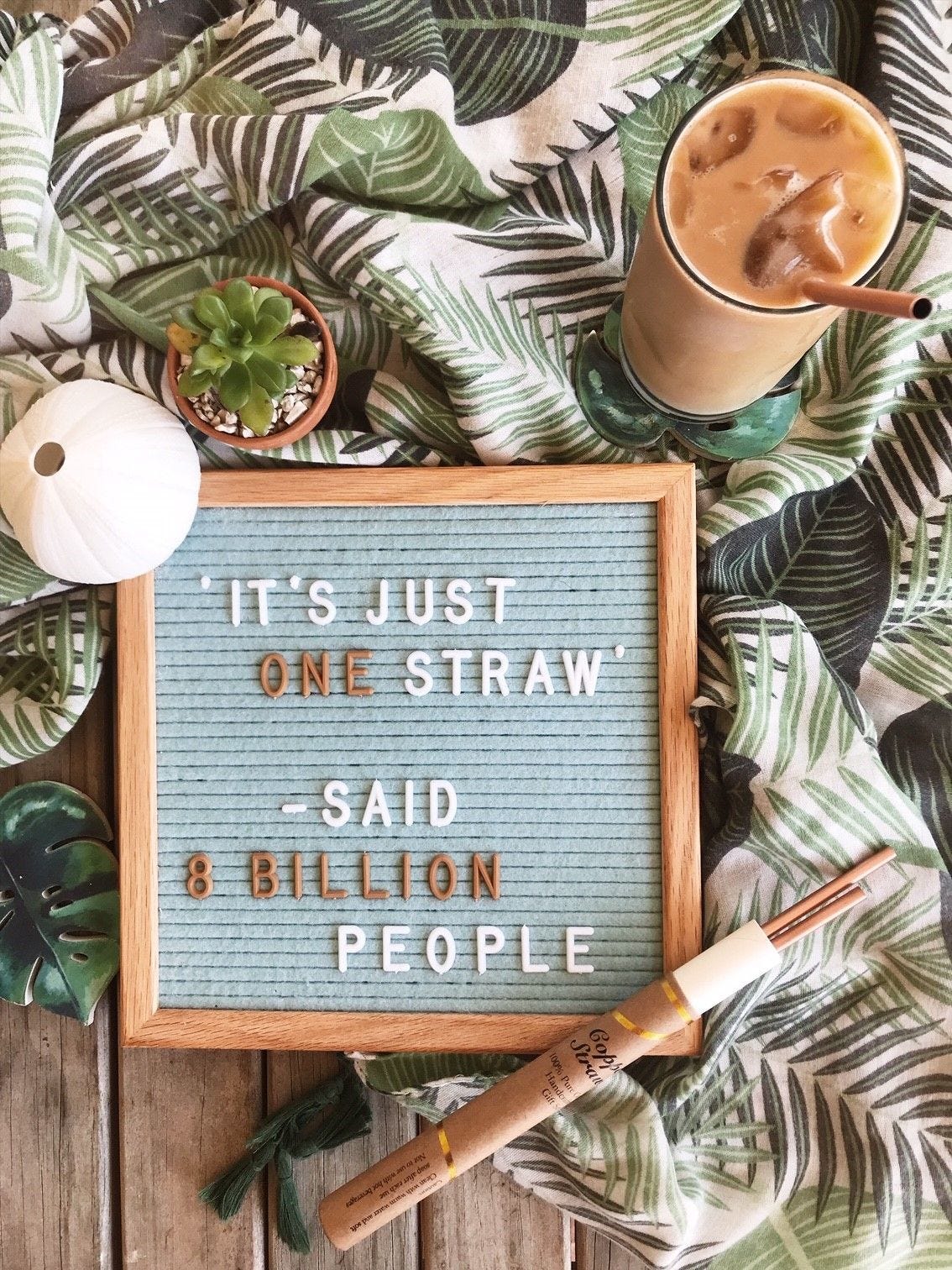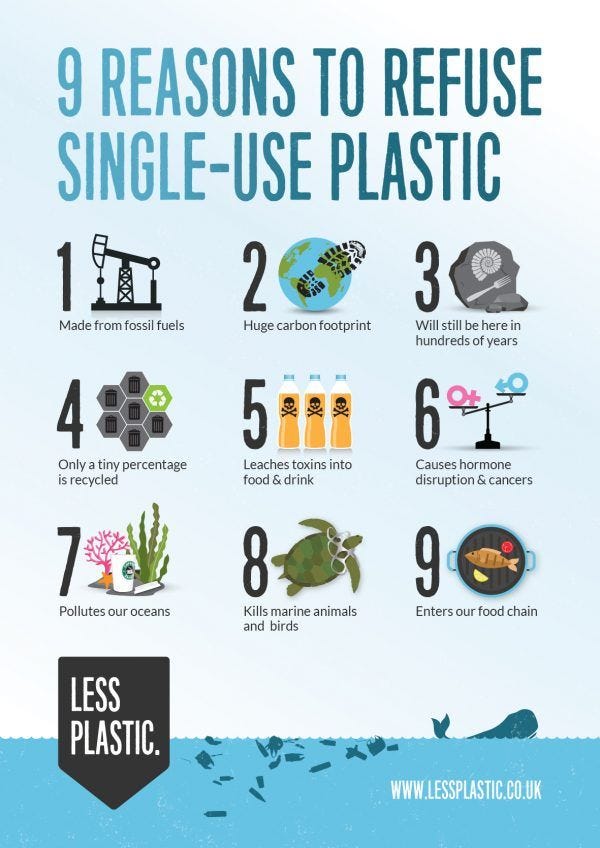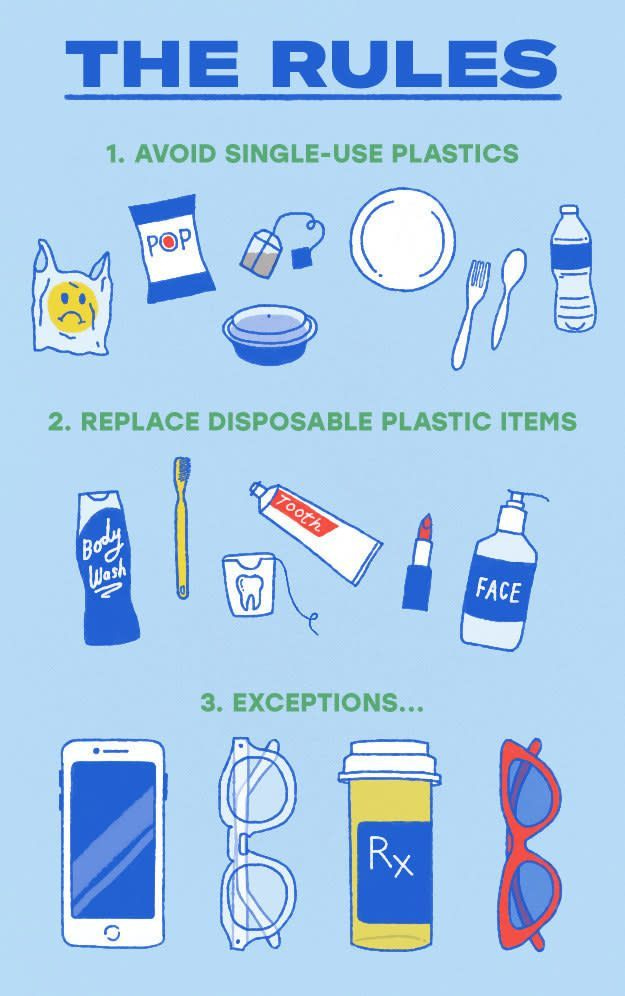Single-Use Plastic
We live in a plastic world, but that doesn't mean we can't make switches to reduce our plastic use.
To those of you who are new here, welcome! For those who have been following, welcome back! As I’ve said before, the environment is something I am really passionate about, and I love sharing ways to become more eco-friendly. In my last few posts, I have talked about how to reduce our carbon footprint and fast-fashion. In this post, I will be talking about single-use plastics and ways to swap these items out for something more sustainable and reusable!
The Problem
Single-use plastics are items that cannot be recycled. The list includes bags, straws, drink bottles, and a lot of food packaging. According to the Plastic Free Challenge website, “We produce roughly 300 million tons of plastic each year and half of it is disposable!” The site also says that only about 10-13% of plastics are being recycled, and of that 10-13%, only about 20% actually is deemed recyclable. According to Pela, it takes approximately 450 years for a single piece of plastic to fully decompose. This means that every piece of plastic that has ever been produced still exists to this day.
As plastic begins to decompose, it breaks down into microplastic, which is just very small pieces of plastic. These microplastics cause harm to ocean life because they can be mistaken as bits of food. Another form of microplastics is called microbeads. According to the National Oceanic and Atmospheric Administration, “Microbeads are tiny pieces of polyethylene plastic added to health and beauty products, such as some cleansers and toothpastes.” Microbeads have existed for over 50 years and will continue to pollute the ocean. (Follow this link to watch a video to learn more about microplastics and microbeads).
Several studies have shown that we, on average, ingest about 5 grams of plastic per week. (This is equivalent to the size of a credit card). Toxic chemicals from the plastic we are ingesting is also being found in our bloodstreams. According to an article by CNN, “The largest source of plastic ingestion is drinking water…[A study] found that the average person consumes as many as 1,769 particles of plastic every week just by drinking water – bottled or from the tap.” The article goes on to say, “A separate study this month found that Americans eat, drink and breathe between 74,000 and 121,000 microplastic particles each year, and those who exclusively drink bottled water rather than tap water can add up to 90,000 plastic particles to their yearly total.” The scariest part of all this is that scientists and researchers still don’t know the full extent of harm that ingesting this much plastic can cause. Luckily, what they do know, is that making simple switches from single-use plastic to the sustainable alternative can slow these processes down and actually have an impact on our health too.
Making the Switch
The good news is that so many of the single-use plastic items that we use every day can be replaced with something that is sustainable and can be used for several years. These items include straws, shopping bags, and drinking cups. The list goes on and on, but I will talk about a few of my personal favorites!
For about two years now, I have refused to use a plastic straw, except when it has already been put in a drink—then I use it so it will not go to waste. (I have learned which restaurants to request “no straw” when ordering my drink). I now keep a reusable straw on me at all times, too. I have one that fits on my keychain, and I also have a few metal and bamboo straws that I put in a few of my bags, so I know I will always have one as back up! I especially make sure to pack one with me when I am traveling. Compostable and paper straws work well too but investing into a few reusable straws is the best way to avoid any waste.
I have also accumulated several reusable totes and shopping bags over the past few years, and no matter how big my shopping haul is, I never run out of bags to use. I like to keep a few in my car, so I also have one on hand. Of course, this was an investment made over time, and I did buy a few too, but the few dollars I spent here and there was worth it if it means I help our planet. If you forget your reusable bag, don’t freak out, I do it too. I like to keep my plastic bags to use for other purposes or to recycle at home. I’ve also bought a few tote bags that serve as a purse, a grocery bag or shopping bag, my school bag, and more. Reducing the amount of plastic use by swapping out for reusable bags is so feasible, anyone can do it. (Plus, many stores offer reusable bags for a few dollars at most)!
The biggest switch I have made is using reusable cups everywhere I go. Reusable cups aren’t as widely accepted right now because of the pandemic, but a lot of places still accept them. Before the pandemic, I brought my reusable cup to places like Starbucks, where they will give you a small discount for brining your own cup! I also like to take a cup or water bottle with me anytime I leave my house. I like to have water or some type of drink on me when I travel, and it is much easier to use my own cup than to have to constantly drive through somewhere to get a drink. I also like to take my own cup or bottle to work with me so that I drink more water while I am there, but I also avoid wasting multiple cups for my drinks. Buying a handful of your own reusable cups and water bottles can save you a lot of money in the long-run, but it also helps our planet!
We are all human and we all make mistakes sometimes. We can’t be perfect and never use plastic when so many of our essentials come in plastic packaging. The most important thing is that we make simple switches here and there and continue to use less plastic as time goes on. In my next post, I will continue to talk about ways to “making the switch” and dive deeper into the impact it can have. Thanks for reading!




I think you might find this episode of John Oliver's "Last Week Tonight" interesting. The series runs on HBO, so there is definitely some foul language/adult subject in this. https://www.youtube.com/watch?v=Fiu9GSOmt8E
Hi Lizzy! I loved your post this week. I will be the first to admit that I do not do my part in making sure I cut down on plastic use. I drink about four to six bottles of water every day because we can't drink tap water at my house. I never knew how harmful this could be for me or the envrioment. I do know Brita's exists and they "filter" the water so to speak. Is there any water filtering system you recommend for a beginner who would like to lead a more sustainable lifestyle?